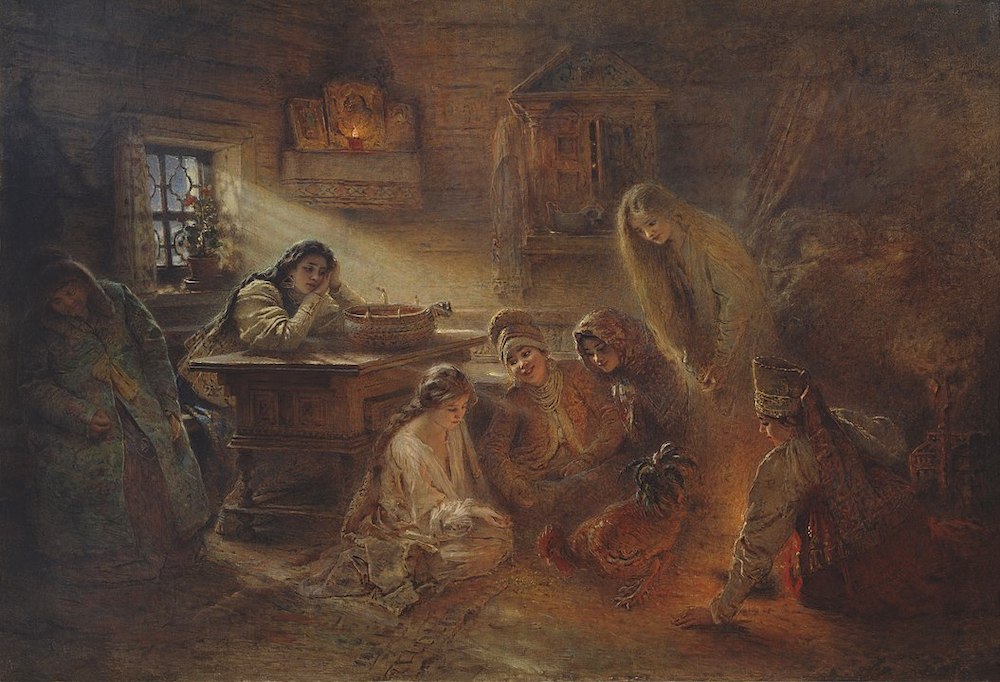The Age of Digital Divination

A man stands in front of a judge, accused of stealing. The judge consults a source that will determine whether to grant bail.
A woman stands in front of a judge, accused of adultery. The judge consults a source that will determine if the claim has merit.
In the first case, the source is a computer; in the second, it’s a chicken.
Both cases, though, are forms of divination: using something (or someone) to foretell the future or discover hidden information about the world.
Anthropologists have been long fascinated by this phenomenon. Back in 1937, the British anthropologist E.E. Evans-Pritchard documented several forms of divination among Zande people in central Africa, one of which involved the aforementioned chicken being fed poison by a diviner. Whether the chicken survived (or not) told an anxious husband or wife if their spouse was cheating. Ethnographic and historical studies have uncovered countless other forms of the practice: the movements of animals such as spiders and snails, patterns burnt into parts of animals such as turtle shells and sheep bones, shapes formed by leaves and sticks, stories revealed by Tarot cards and palm lines, and much more.
Likewise, digital divination using predictive analytics software promises to foretell the future and reveal underlying truths about the world. Predictive tools based on machine learning and artificial intelligence are now being applied to relatively banal—yet complex—phenomena, from forecasting house prices, to speculating on the movements of financial markets, to guessing customer satisfaction with a business. But machine predictions also veer into the profound: New computational tools try to determine the likelihood of whether someone is liable to skip bail, as in the vignette above, or how sick you’ll get from contracting COVID-19.
Whatever the form, divination tends to offer a narrow view of the future based on answers to specific questions—leaving little room for alternative visions of what could be.
A recent article by anthropologists Kevin Hong and Joe Henrich, both at Harvard University, provides a comprehensive overview of divination. This practice, they say, serves many purposes: from resolving disputes, reducing anxiety about a situation, or clearing the hurdle of indecision, to inferring meaning about the world, inquiring about fate, or deciding when and how to go to war.
Divination is a way of revealing otherwise unknowable and unobtainable information about important matters. But interestingly, diviners are not often considered to be the ones who possess this information. They are skilled technicians who can read what’s hidden elsewhere: in the cards, the tea leaves, the entrails—or the algorithms.
Calling diviners “skilled technicians” might sound odd to contemporary Westernized, post-Enlightenment ears. But there’s a long history of linking soothsaying with mundane daily activities. In the fourth century B.C., Plato wrote about divination as a highly regarded technical skill (mantikē technē). Around 400 years earlier in the Odyssey, the ancient Greek epic poem attributed to Homer, divination is listed as a craft alongside doctors and carpenters (although Cicero, writing a few centuries later, was somewhat sniffy about the practice). Early Chinese thinkers similarly put diviners into the same category as artisans. Indeed, divination and science were once bedfellows: In the 17th century, when divisions between science, religion, and art were blurrier, the scientist Johannes Kepler practiced both astronomy and astrology, writing more than 800 horoscopes in his lifetime.
The idea of skilled technicians undertaking obscure and seemingly magical practices to forecast the future or reveal hidden information about the world sounds very much like today’s developers of digital predictive technologies.
The similarities don’t end there. In many societies around the world, diviners charge hefty sums for their services, and not everybody has the chance to consult with them. So, too, can tech wizards familiar with AI and machine learning command hefty salaries for their arcane knowledge and access to the software they produce.
It’s worth pointing out one major difference between digital divination and more traditional forms: the potential scale of their negative effects. Whereas much divination affects only individuals or families, the kinds of algorithms employed by corporations and the state, such as “predictive policing,” can perpetuate systemic inequalities and racist profiling. That’s because they base their predictions on datasets that are often already biased against particular groups of people.
Given their fallibility, why do so many of us continue to place such stock in predictions from a machine or a divination?
A simulation developed by anthropologists Hong and Henrich tried to answer this. They found several things that can lead people to overestimate how well a divination worked. One is strong prior beliefs: The practice sounds plausible and is intuitively appealing. I’d argue this applies to machine predictions too. Another is that failed predictions tend to go underreported or are explained away; companies making AI predictions have a similar incentive to downplay their mistakes.
Divination tends to offer a narrow view of the future based on answers to specific questions—leaving little room for alternative visions of what could be.
A third factor is that potential benefits from a foretelling are perceived to be higher than the costs of going to a diviner. Paying for access to machine predictions—or having them bundled into mobiles phones and smart watches—likewise seems cheap given the benefits of potentially predicting whether you’ll have a heart attack or whether a person might commit another crime.
Some types of divination are seen as trustworthy and reliable because they claim to channel or commune with supernatural beings—as when spirits possess a medium to pronounce on the outcomes of key events like harvests. While there may be nothing supernatural about digital divination, it, too, seems ineffable.
In both cases, nonspecialists can’t really check the effectiveness of divination themselves.
And that’s part of the danger: Divination is presumably not based on causal links between, say, trails of snail mucus and the risk of heart disease. Likewise, much of current artificial intelligence is not based on causal models of the world. Machine predictions, for the time being, rely on spotting statistical patterns within large datasets—but correlations are not causation. Without solid models of the world, digital divination could end up raising costly or frightening false alarms by, say, convincing people to seek medical treatments they don’t really need, or setting a bail too low or too high.
As deeply social creatures, humans are disposed to learn from others. Anthropologists have found that information about how well divinations work often arrives through testimony rather than direct experience.
In other words, all these technologies of knowing—from augury to astrology to artificial intelligence (no matter how firmly based in material reality)—work best when augmenting our decision-making rather than replacing it. When technologies build on our expertise and experiences, then they become truly useful.
Whether digital, physical, or supernatural, divination in all its forms seems to offer narrow sketches of the future: a prediction about a singular event that may or may not happen, for example. But in putting faith in these predictions, we may be foreclosing other possibilities we haven’t yet imagined.
What if we relied on a more prosaic method—one that harnesses the most powerful prediction engine in the world: our brains?
Imagining possible futures—and engaging in these acts of imagination together—might be more likely to lead us into a future we’d prefer. That would mean taking responsibility for designing what’s possible out of the hands of a small number of technologists and other specialists, and instead including as many people as possible in dreaming the future—especially those who have been marginalized and all too often experience negative effects from decisions made about them without their input. It would mean shifting from “What’s going to happen?” to “What if … ?”


































